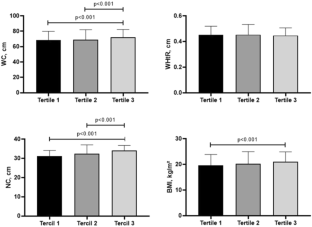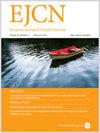儿童和青少年心脏代谢风险的相位角和人体测量指标
IF 3.6
3区 医学
Q2 NUTRITION & DIETETICS
引用次数: 0
摘要
理论依据/目的相位角(PhA)是从生物电阻抗检查中发现的电阻和电抗中得到的测量值,在评估营养状况和心脏代谢疾病方面非常有用。因此,本研究的目的是将相位角与儿童和青少年心脏代谢风险(CMR)的人体测量变量相关联。PhA按三等分进行评估,CMR则使用人体测量变量BMI、WC、NC和WHtR进行鉴定。采用线性回归模型来验证 PhA tertiles 与 CMR 人体测量变量之间的关系,并按性别进行分层。在青少年中,男孩的 NC 值(β = -0.019,p = 0.005)和 BMI 值(β = -0.025,p = 0.023)较低,男孩的 WC 值(β = -0.017,p = 0.020)、WHtR 值(β = -0.017,p = 0.020)、NC 值(β = -0.011,p = 0.结论 在接受评估的青少年中,PhA 与 CMR 直接相关。本文章由计算机程序翻译,如有差异,请以英文原文为准。


Phase angle and anthropometric indicators of cardiometabolic risk in children and adolescents
The phase angle (PhA) is a measurement obtained from the resistance and reactance found in the bioelectrical impedance examination and is useful in assessing nutritional status and in assessing cardiometabolic diseases. Therefore, the objective was to correlate the phase angle to the anthropometric variables of cardiometabolic risk (CMR) in children and adolescents. Weight, height, body mass index (BMI), waist circumference (WC) and neck circumference (NC), waist-to-height ratio (WHtR), and PhA of 1231 children and adolescents aged between 5 and 18 years were assessed. PhA was assessed in tertiles and CMR was identified using the anthropometric variables BMI, WC, NC, and WHtR. Linear regression models were used to verify the association between PhA tertiles and CMR anthropometric variables, stratified by sex. No relationship was found between PhA and CMR variables in children. In adolescents, lower values of NC (β = -0.019, p = 0.005) and BMI (β = -0.025, p = 0.023) were found in boys, WC (β = -0.017, p = 0.020), WHtR (β = -0.017, p = 0.020), NC (β = -0.011, p = 0.027) and BMI (β = -0.026, p = 0.009) in girls when they were in tertile 1 when compared to tertile 3 of the PhA, even after adjusting for age. The PhA was directly associated with CMR in the assessed adolescents.
求助全文
通过发布文献求助,成功后即可免费获取论文全文。
去求助
来源期刊
CiteScore
10.60
自引率
2.10%
发文量
189
审稿时长
3-6 weeks
期刊介绍:
The European Journal of Clinical Nutrition (EJCN) is an international, peer-reviewed journal covering all aspects of human and clinical nutrition. The journal welcomes original research, reviews, case reports and brief communications based on clinical, metabolic and epidemiological studies that describe methodologies, mechanisms, associations and benefits of nutritional interventions for clinical disease and health promotion.
Topics of interest include but are not limited to:
Nutrition and Health (including climate and ecological aspects)
Metabolism & Metabolomics
Genomics and personalized strategies in nutrition
Nutrition during the early life cycle
Health issues and nutrition in the elderly
Phenotyping in clinical nutrition
Nutrition in acute and chronic diseases
The double burden of ''malnutrition'': Under-nutrition and Obesity
Prevention of Non Communicable Diseases (NCD)

 求助内容:
求助内容: 应助结果提醒方式:
应助结果提醒方式:


